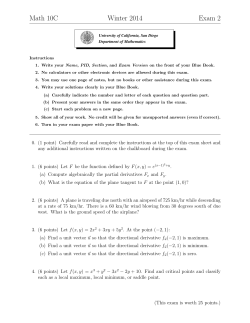
Measuring the effects of monetary policy a Factor
Measuring the effects of monetary policy a Factor-augmented vector autoregressive (FAVAR) approach Bernanke, Boivin and Eliasz QJE(2005) Overview Structural vector autoregressions (SVAR) are widely used to trace out the effect of monetary policy innovations on the economy. • Policy innovations are likely to be contaminated. • The choice of a specific data series to represent a general concept such as ”real activity” is arbitrary to some degree. • Impulse response functions can be observed only for the included variables. This paper: Combines VAR analysis with recent developments in factor analysis for large data sets. Factor-augmented vector autoregression FAVAR Yt is a M × 1 vector of observable economic variables. Ft is a K × 1 vector of unobservable factors. Their dynamics are given by: Ft Ft−1 = Φ(L) + νt Yt Yt−1 (1) Xt is a N × 1 vector of ”informational” time series. where K + M N They assume that: Xt = Λf Ft + Λy Yt + et (2) Motivating the FAVAR Structure: An Example Consider the simple backward-looking model: n πt = δπt−1 + κ(yt−1 − yt−1 ) + st (3) yt = φyt−1 − ψ(Rt−1 − πt−1 ) + dt (4) n ytn = ρyt−1 + ηt (5) st = αst−1 + υt (6) Rt is set by the central bank according to a simple Taylor Rule: Rt = βπt + γ(yt − ytn ) + εt (7) The macroeconomic indicators are assumed to be related in the following way: Xt = Λ[ytn st πt yt Rt ]0 + et (8) The model can then be written in as a VAR(1) where, Φ = υt ρ 0 −κ 0 −γψ 0 0 = 0 1 γ 0 0 0 0 1 0 α α 0 βα 0 0 δ ψ (βδ + λψ) 1 0 dt 0 1 εt 0 1 ηt 0 0 υt −γ β 0 0 0 0 κ 0 φ −ψ (βκ + λφ) −(βκ + λρ) What is Ft and Yt in this model? If all the variables are observed then [ytn st πt yt Rt ]0 Yt = Ft = ∅ If potential output and the cost-push shock are not observed then: Yt = [πt yt Rt ]0 Ft = [ytn st ]0 The most realistic setting is one in which: Yt = [Rt ]0 Ft = [ytn st πt yt ]0 Estimation I A two step principle components approach: • A nonparametric way of uncovering the common space spanned by the factors of Xt , denoted C(Yt , Ft ). • First step involves using the first K + M principal components of ˆ t , Ft ). Xt to first estimate the space spanned by the factors C(Y ˆ Then they can obtain Ft . • Second step involves estimating the FAVAR equation with Ft replaced by Fˆt . • To account for the uncertainty of the ”generated regressor” in the second step they implement a bootstrap procedure when computing impulse response functions. Estimation II Likelihood based inference using the Gibbs sampler. • Can handle the difficult nature of the likelihood function which makes MLE infeasible for models like this. • Need to assume errors are normally distributed. • Idea is to characterize the joint posterior P (Θ, F T |X T , Y T ) by sampling from the conditional densities P (F T |Θ, X T , Y T ) and P (Θ|F T X T , Y T ). The state space form of the model is: Ft Yt Xt Yt = Φ(L) f Λ = 0 Ft−1 + νt Yt−1 Ft et Λy Yt 0 0 Identification Two identification issues: • Normalization • Recall that Xt = Λf Ft + Λy Yt + et . So if Λˆf and Fˆt are a solution to the estimation problem then Λ˜f = Λˆf H and F˜t = H −1 Fˆt are also valid solutions. • Identification of the structural shocks • Recursive structure in which all the factors respond with a lag to a change in the monetary policy instrument, which is ordered last in Yt . • Notice that the FAVAR framework allows for other identification schemes. (e.g. long-run restrictions or arbitrary contemporaneous restrictions). The Dynamic Effects of Monetary Policy • In their application Xt consists of a balanced panel of 120 monthly macroeconomic time series. • The recursive ordering imposes the identifying assumption that the unobserved factors do not respond to monetary policy innovations within the period. • For the principle component estimation approach they need to ˆ t , Yt ) on Rt . They estimate remove the direct dependence of C(F the coefficient through a multiple regression of the form ˆ t , Yt ) = bC ∗ Cˆ ∗ (Ft ) + bR Rt + et C(F where to obtain Cˆ∗ (Ft ) they extract principal components from a subset of slow-moving variables of Xt .
© Copyright 2025









